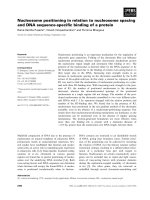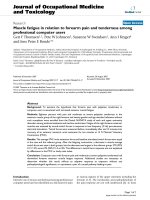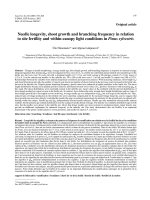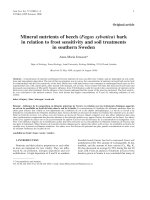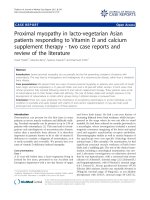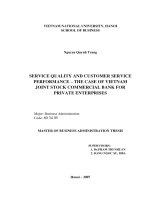Livelihood impacts of adaptive measures in relation to coastal inundation and submersion in ghana the case of ningo prampram coastal area in greater accra region
Bạn đang xem bản rút gọn của tài liệu. Xem và tải ngay bản đầy đủ của tài liệu tại đây (5.36 MB, 142 trang )
MINISTRY OF EDUCATION AND TRAINING
NHA TRANG UNIVERSITY
GEORGE DARKO
LIVELIHOOD IMPACTS OF ADAPTIVE MEASURES IN
RELATION TO COASTAL INUNDATION AND SUBMERSION
IN GHANA. THE CASE OF NINGO-PRAMPRAM COASTAL
AREA IN THE GREATER ACCRA REGION
MASTER THESIS
KHANH HOA, 2019
MINISTRY OF EDUCATION AND TRAINING
NHA TRANG UNIVERSITY
GEORGE DARKO
LIVELIHOOD IMPACTS OF ADAPTIVE MEASURES IN
RELATION TO COASTAL INUNDATION AND SUBMERSION
IN GHANA. THE CASE OF NINGO-PRAMPRAM COASTAL
AREA IN THE GREATER ACCRA REGION
MASTER THESIS
Major
Marine Ecosystem
Management and Climate
Change
Topic allocation Decision
29CH259
Decision on establishing the committee:
02-04 August, 2019
Defence date:
Supervisor:
Chairman
Faculty of Graduate Studies
Hoang Ha Giang
KHANH HOA, 2019
Supervision
Major:
Marine Ecosystem Management
and Climate Change
Code:
59CH259
Topic allocation Decision:
654/QD-DHNT dated 25/3/2014
Decision on establishing the
654/QD-DHNT dated 16/4/2015
Committee:
Defence date:
Supervisor:
PROFESSOR JAHN PETTER
JOHNSON
Chairman of Committee:
Faculty of Graduate Studies
02-04 August, 2019
UNDERTAKING
I undertake that the thesis entitled: ‘‘Livelihood impacts of adaptive measures in
relation to coastal inundation and submersion in Ghana. The case of NingoPrampram Coastal Area in Greater Accra Region’’ is my own work. The work
has not been presented elsewhere for assessment until the time this thesis is
submitted.
----- Date 30
Month: May
Year: 2019
George Darko
i
ACKNOWLEDGEMENT
My utmost appreciation goes to Nha Trang University and Tromso University
respectively for the space and resources that made it possible for a successful
completion of my whole academic study in Nha Trang, Vietnam.
To Professor Jahn Petter Johnson (University of Tromso), I am most delighted to
express my heartfelt gratitude for your relentless devotion in supervising this
dissertation. Your comments and directions have guarded the success of this work
to its completion. Your supervision has been very useful in building my
understanding of conducting a study and equipping me for the future studies. I will
posit that I am the luckiest student to have you as my supervisor.
To my lecturers and professors, Professor Kim Anh Thi Nguyen (Nha Trang
University), Professor Curtis M. Jolly (Auburn University, USA), all and sundry,
who contributed in diverse ways to the success of my study, words could not
describe the gratitude I owe you all. God bless you.
Finally to Isaac Sarfo and the data collection team, kudos.
………Date 30 Month: May Year: 2019
George Darko
ii
TABLE OF CONTENTS
UNDERTAKING ............................................................................................... i
ACKNOWLEDGEMENT ................................................................................ii
TABLE OF CONTENTS ................................................................................ iii
LIST OF ABBREVIATIONS .......................................................................... vi
LIST OF TABLES .......................................................................................... vii
LIST OF FIGURES........................................................................................viii
ABSTRACT ...................................................................................................... ix
CHAPTER ONE: .............................................................................................. 1
INTRODUCTION ............................................................................................. 1
1.1 BACKGROUND ........................................................................................... 1
1.2 RESEARCH PROBLEM AND OBJECTIVES.............................................. 4
1.3 RESEARCH QUESTIONS ........................................................................... 6
1.3.1 EXPECTED RESULTS.............................................................................. 6
1.4 SIGNIFICANCE OF THE STUDY ............................................................... 7
1.5 CHAPTER ORGANIZATION ...................................................................... 7
CHAPTER TWO .............................................................................................. 9
LITERATURE REVIEW AND THEORY ...................................................... 9
2.1 INTRODUCTION ......................................................................................... 9
2.1.1 CLIMATE CHANGE IN GHANA ........................................................... 11
2.1.2 CAUSES OF INUNDATION AND GRADUAL SUBMERSION ............ 12
2.1.3 A REVIEW ON ADAPTATIONS ON IMPACTS OF INUNDATION
AND SUBMERSION........................................................................................ 13
2.2 THEORETICAL FRAMEWORK ............................................................... 14
2.2.1 CONCEPTUAL FRAMEWORK OF VULNERABILITY AND
ADAPTATION TO INUNDATION AND SUBMERSION OF COASTAL
AREAS. ............................................................................................................ 15
2.2.2 Coastal Vulnerability ................................................................................ 17
2.2.3 Adaptive Capacity .................................................................................... 19
2.2.4 Adaptation Constraint ............................................................................... 20
CHAPTER THREE: ....................................................................................... 23
iii
METHODOLOGY AND METHODS ............................................................ 23
3.1 INTRODUCTION ....................................................................................... 23
3.2 Study Design ............................................................................................... 23
3.3 Source of Data ............................................................................................. 25
3.3.1 Vulnerability Matrix ................................................................................. 25
3.3.2 Focus Group Discussion ........................................................................... 27
3.3.3 Questionnaire ........................................................................................... 27
3.4 Sampling ..................................................................................................... 28
3.4.1 Sampling Method ..................................................................................... 29
3.5 Data Analysis and Presentation.................................................................... 30
3.6 Limitations of the Study .............................................................................. 30
3.7 Validity and Reliability ............................................................................... 31
CHAPTER FOUR: .......................................................................................... 33
DESCRIPTION OF THE CASE AREA ........................................................ 33
4.1 INTRODUCTION ....................................................................................... 33
4.1.1 The Greater Accra Region: Locating Accra .............................................. 33
4.1.2 Characteristics of the Greater Accra Region ............................................. 34
4.1.3 The Case Site Ningo-Prampram................................................................ 37
4.2 BACKGROUND INFORMATION ON REESPONDENTS........................ 39
4.3 Summing up the case description. Relevance for answering the RQs ........... 44
CHAPTER FIVE: ............................................................................................ 45
RESULTS ON ASSETS AND LIVELIHOODS ............................................ 45
5.1 INTRODUCTION ....................................................................................... 45
5.2 Assets .......................................................................................................... 45
5.2.1 Knowledge Asset and Acquisition ............................................................ 45
5.2.2 Physical and Capital Assets ...................................................................... 48
5.2.3 Asset Income ............................................................................................ 54
5.2.4 Asset Insurance......................................................................................... 56
5.3 Summary of the livelihood activities and returns from them ........................ 57
CHAPTER SIX: .............................................................................................. 58
RESULTS, FINDINGS AND DISCUSSIONS ............................................... 58
6.1 INTRODUCTION ....................................................................................... 58
6.2 Results and Findings.................................................................................... 58
iv
6.2.1 Focus Group Discussion and Vulnerability Matrix ................................... 58
6.2.2 Impacts of Inundation and Submersion on livelihoods in the NingoPrampram coast ................................................................................................. 61
6.3 Coping and Adaptation and their impacts on livelihoods ............................. 66
6.3.1 Individual household coping and adaptation ............................................. 66
6.4 Intervention Programs in Ningo-Prampram ................................................. 68
6.4.1 Sea Defense Wall and Dyke...................................................................... 68
6.4.2 Mangroves and Coconut trees ................................................................... 69
6.4.3 Drainage and Irrigation Systems ............................................................... 70
6.5 Institutional Aid and Support ....................................................................... 70
6.6 Impacts of Adaptive measures ..................................................................... 72
CHAPTER SEVEN ......................................................................................... 75
DISCUSSIONS, CONCLUSION AND FURTHER RESEARCH ................ 75
7.1 DISCUSSIONS ........................................................................................... 75
7.2 CONCLUSION ........................................................................................... 79
7.2.1 Lessons:.................................................................................................... 80
7.2.2 Best Practices ........................................................................................... 81
7.3 RECOMMENDATIONS AND FURTHER RESEARCH ............................ 82
7.4 FURTHER RESEARCH ............................................................................. 83
REFERENCE .................................................................................................. 85
APPENDIX I ................................................................................................... 91
1.1 INTERVIEW GUIDE.................................................................................. 91
APPENDIX II .................................................................................................. 98
1.2 FREQUENCY TABLES – SPSS ................................................................. 98
APPENDIX III .............................................................................................. 126
1.3 FIGURES FROM SAMPLING ACTIVITIES ........................................... 126
v
LIST OF ABBREVIATIONS
AMA
Accra Metropolitan Assembly
DA
District Assembly
DECCMA Deltas, Vulnerability & Climate Change: Migration & Adaptation
DFID
Department for International Development
FDG
Focus Group Discussion
GAMA
Greater Accra Metropolitan Area
GMA
Ghana Meteorological Agency
GSS
Ghana Statistical Service
IFRC
International Federation of Red Cross
IPCC
Intergovernmental Panel on Climate Change
MMDA
Metropolitan, Municipal and District Assembly
NADMO
National Disaster Management Organization
NCCAS
National Climate Change Adaptation Strategy
NDPF
National Decentralization Policy Framework
SPSS
Statistical Package for Social Sciences
UNCCD
United Nations Convention to Combat Desertification
UNEP
United Nation Environmental Program
UNDP
United Nations Development Program
VCA
Vulnerability and Capacity Approach
WHO
World Health Organization
WMO
World Meteorological Organization
vi
LIST OF TABLES
Table 3.1 Vulnerability Matrix 1................................................................................ 26
Table 3.2 Vulnerability Matrix 2................................................................................ 26
Table 4.1. Gender Of Respondents In Ningo Prampram ............................................. 39
Table 4.2 Age Intervals Of Respondents .................................................................... 39
Table 4.3: Educational Background Of Respondents ................................................. 40
Table 4.4: Primary Occupation Of Respondents......................................................... 41
Table 4.5 Alternative Livelihood Of Respondents...................................................... 42
Table 5.1 Media For Acquiring Climate Change Knowledge ..................................... 47
Table 5.2 Institutions That Provide Knowledge On Climate Change .......................... 48
Table 5.3 Building Material Composition Of Housing Units ...................................... 49
Table 5.4 Assets, Their Status And Cost Intervals ...................................................... 51
Table 5.5 Net-Income From Other Sources Apart From Fishing And Farming........... 54
Table 6.1 Vulnerability Matrix Of Fdg....................................................................... 59
Table 6.2 Impacts Of Climate Change On Coastal Livelihoods .................................. 60
Table 6.3 Rankings Vulnerability Categories/Livelihoods ......................................... 61
Table 6.4 Ranking Climate Events/Stressors .............................................................. 61
Table 6.5 Impacts Of Inundation And Submersion On Livelihoods ........................... 62
Table 6.6 Household Coping And Adaptations .......................................................... 67
Table 6.7 Assistance, Interventions And Importance .................................................. 73
vii
LIST OF FIGURES
Figure 2.1 Coastal inundation and gradual submersion and associated impacts.
15
Figure 2.2. Effects of exposure, sensitivity and adaptive capacity
17
Figure 2.3. Conceptual model of vulnerability
18
Figure 2.4. The vulnerability scoping diagram
19
Figure 2.5. Adaptation contraints
20
Figure 3.1 Focus group discussion with key personalities
29
Figure 3.2 Focus group discussion 2
29
Figure 4.1 New map of ghana
33
Figure 4.2: Districts of the Greater Accra Region (population & housing census, 2010)
36
Figure 4.3 Ningo-prampram beach depicting an open and exposed coast
38
Figure 4.4 Satellite picture of ningo prampram
38
Figure 4.7 Range of years respondents have lived in the study area
43
Figure 5.1 Bar chart of asset knowledge of respondents
46
Figure 5.2 Tenure status of housing units of respondents
49
Figure 5.3 Assets owned by respondents
51
Figure 5.4 Insurance as an asset to local dwellers of ningo-prampram
56
Figure 6.1 Affected houses in ningo-prampram
63
Figure 6.2 Fishermen at the shores of the study site
65
Figure 6.3 The sea claiming the coastal land
66
Figure 6.4 Coastal defense by resorts to protect their business
68
Figure 6.5 District assembly, ningo-prampram
69
Figure 6.6 State of mangroves and coconut trees in ningo-prampram
69
Figure 6.7 venn diagram of institutions with level of assistance
71
viii
ABSTRACT
Undeniably factual, the world has undergone changes as a result of natural and
human induced factors in the atmosphere and land use. The results of these changes
are global warming which has given rise to sea level rise, flooding in low-lying
coastal regions and submersion. Studies have shown that Greater Accra in general
is a low-lying region that has an open and exposed coast which allows unhindered
strong waves from the Gulf of Guinea. Thus, this study aimed at finding the
livelihood impacts of adaptive measures in relation to inundation and submersion,
specifically in the Ningo-Prampram coast. Based on Macchi’s community-based
vulnerability and capacity assessment approach which has its foundations on the
sustainable livelihood approach, research questions were formulated and answers
sought to them. Focus group discussions were held to ascertain the major climate
and non-climate events, their impacts and vulnerable areas. The focus group
discussion was followed with face-to-face survey of 70 respondents and this
revealed inundation and submersion as the major stressors that trigger dysfunctions
of fishing, farming, and others that consist the major livelihoods of residents in the
study site. Impacts range from collapse of several buildings along the beach, salt
water intrusion rendering farmlands infertile and unproductive. The ones
farmlands for growing cabbage and chilli pepper are no more rather these lands
have been sold to estate developers and the coastal land has been claimed by the
sea by one (1) to two (2) kilometres. As regards adaptations, residents basically
harvest rainwater and most times have to evacuate temporary. Residents per these,
have joined credit unions and other micro-finance institutions so as to save some
money and get financial aid. To residents, this is the business as usual. Irrespective
of the coast been open and exposed to the Gulf of Guinea, no significant
adaptations are found except some few ones built by resorts and hotels to protect
their businesses. Other natural adaptations found include mangroves and coconut
trees but they are mostly harvested and very few remain on the coast with no plans
for afforestation and replanting them. The Ghana government has plans to extend
the sea defence system from Ada through to Ningo-Prampram. This has not been
initiated and therefore, leaving the Ningo-Prampram coast highly vulnerable with
low adaptive capacity. Livelihoods are therefore impacted negatively.
ix
.
CHAPTER ONE:
INTRODUCTION
1.1 BACKGROUND
The earth has undergone warming and cooling numerous times since it was
formed over billions of years ago (King et al, 2015). These are as a result of
both natural and human induced changes within the atmosphere and in land use.
There have been high rates of sea level rise as a result of global warming in the
21st century. This has given rise to expected submersion and occasional
flooding tide in low-lying coastal environments (Appeaning, et al, 2011).
It has been 100 years till now since concerns on fossil fuel burning that
eventually contribute to high levels of carbon dioxide in the earth’s atmosphere,
and subsequently lead to climate change were raised (Kulkarni, 2010). But it
must be emphasized that it is only in recent times that governments and
environmental stakeholders have realised how human activities have,
influenced the earth’s climate. It is evident that the harsh effects of climate
change is much felt in the sub-Saharan Africa and its respective coasts, together
with the coastal areas of the Indian and Pacific oceans which are most
vulnerable in terms of coping and adaptive mechanisms. The world Health
Organization (WHO) estimates that climate changes causes over one hundred
and fifty thousand (150,000) deaths in the sub-region (WHO World Health
Report, 2002).
To these effects and awareness created, governments, policy makers and
international organizations have made it a priority to adapt and commit to
initiatives that seek to mitigate the climate change phenomena if could not be
prevented. For instance, the Intergovernmental Panel on Climate Change
(IPCC) was set up by the World Meteorological Organization (WMO) and the
United Nations Environment Programme (UNEP), basically to provide an
unbiased source of scientific information. In the fifth assessment report (IPCC,
2013), the focus was on the science of climate change, it made explicit
conclusions that climate change is real and human activities are the main
causative agents. The report also provided a complete assessment of sea level
rise and its devastating cause and effects over the years gone by. The new IPCC
1
report; the AR5, buttresses that the earth is warming up at a rate which is more
than the global average with human induced activities accounting for
approximately 1 oC that is above the pre-industrial levels in 2017 and this is
increasing at 0.2 oC every decade.
More so, a pledge of one Hundred Billion US dollars was made at the UN
conference in Copenhagen. This move was to give a solid financial backing to
support response efforts and adaptation measures to climate change.
Ghana has not been spared of the effects of climate change. Especially, in its
coastal belt, where flooding, impacts from storm and erosion are rampant and
problem. For instance, the CityStrength Resilient Cities Program in its report
‘’Enhancing Urban Resilience in the Greater Accra Metropolitan Area (2017),
highlights the major shocks as identified by the local stakeholders during the
CityStrength workshop. The report mentions flooding and coastal erosion, with
associated tidal surge, windstorm and earthquake as the major shocks faced by
the Greater Accra Metropolitan Area (GAMA). These natural phenomena
impact infrastructure for transport and food production and cause building
collapses. These shocks have significantly affected negatively on food security,
the economic structure, private and public properties and infrastructures, the
general coastal habitat, lives of the coastal dwellers and overall displacement of
people’s traditional homes along the coastal areas. In addition, torrential heavy
downpour has contributed immensely to sea level rise which in effect resulted
in coastal inundation and gradual submersion of the coastal belt of Accra of
which the study area is included. A report is given by (Asumadu et al, 2015),
showing the rainfall patterns which increase yearly and as an agent for major
flooding in the capital city of Accra and its low lying coastal areas. In this study,
the focus will be on, Ningo- Prampram which is one of the sixteen districts
merged between Ningo and Prampram in the Greater Accra region of Ghana.
The district and as the study area, is bounded to the north by Shai-Osudoku
district, south by the Gulf of Guinea and in the east and west by Ada East and
Kpone-Katamanso districts respectively. The study area spans over a total land
area of about 622.2 square kilometres with a population size of 70,923 of which
about 28.5 percent are engaged in fishery work (Ghana Statistical Service,
2
2018). The Ningo-Prampram district is again located about 15 km to the east of
Tema and about 40 km from Accra the capital of Ghana. Found on latitude
5.31800N and 0.100100W respectively, along the Gulf of Guinea.
Notice should be taken therefore, that, Ningo-Prampram is similar to most parts
of the Accra Coast that has relatively an open and exposed coast that enables
considerably strong unimpeded swell waves to reach the coast and break
obliquely given rise to long shore currents. The significant wave height for 50
percent of the time is about 1.4 m, the period is between 10 to 15 seconds and
spring tide is about 1.26 m (Appeaning et al, 2011). The description given tend
to make the district prone and vulnerable to occasional and recurrent sea level
rise, unimpeded inundation and submersion which was evidenced in the recent
June 3 flooding which claimed human lives and properties in the Greater Accra
region. These phenomena have put pressure on the economic activities, ecology
and residential areas, making them vulnerable.
The phenomena of climate change has not been overlooked, several counter
policies, plans and projects have been initiated by the Government of Ghana,
Private firms, international donors, at community, households and individual
levels. A responsibility has been bestowed on the MMDA’s to ensure the overall
urban development which is informed by the Local Government Act, 1993 (Act
462) and the National Decentralization Policy Framework (NDPF, 2015-2019).
This responsibility however, is subjected to policy directives and guidance,
planning, evaluation and monitoring responsibilities of national level urban
sector ministries, departments and agencies. The National Climate Change
Adaptation Strategy (NCCAS) was adopted in 2010 with strategies enshrined
to institutionalize the policy’s plans, programs and projects in local areas
through District Assemblies across the country to enhance resilience, adaptive
capacity and mitigations (Nutsukpor, 2013).
In light of these developments, this study aims to explore the impacts of such
programs, coupled with several coping and adaptation strategies that are in place
and their effects on the livelihoods of households in the coastal community.
3
1.2 RESEARCH PROBLEM AND OBJECTIVES
The research has been prompted by the huge impact on people’s livelihood as a
result of inundation and submersion. A report on floods in the capital coastal
areas of Accra revealed that inundation coupled with submersion of the coastal
area claimed over one hundred and fifty (150) lives after hours of rainfall. And
properties destroyed was estimated at GHc 1,658,847 ($ 377,000) (GSS, 2015).
The District-Level Stakeholders’ Meeting of the DECCMA Project NingoPrampram District (2015) identifies that in few decades past, the capital city has
been experiencing an increasing trend of climate change events that have
triggered consistent inundation and gradual submersion of the coastal belt of
Ningo-Prampram and its effects on livelihoods. Again, sea level rise has
resulted in inundation and gradual submersion along the 37 km shoreline of
Prampram and Old Ningo.
Based on recent available data, it is concluded that there has been sea level rise
of 2.1 cm per year in the last 30 years. The rise is estimated at 5.8 cm, 16.5 cm
and 34.5 cm by 2020, 2050 and 2080 respectively. Data identifies that coastal
erosion and salt water intrusion are the major associated problems that impact
Ningo Prampram and other coastal areas in the Greater Accra Region (NCCAS,
2010). These have resulted in displacement of many homes and infrastructure.
Many have lost their livelihoods and fishing in Ningo-Prampram is no more
attractive as fishermen have lost dock areas. It is hoped that the problem of
inundation and submersion will worsen in the next thirty (30) to forty (40) years.
Among the several impacts, there exist several budget hotels on the beach front
and a modern polo grounds and club which have been rendered dysfunctional
as a result of inundation and submersion of the coast.
More so, it has been identified that most of the baobab trees and the mango
plantation, mangroves and coconut trees along the Ningo-Prampram beach have
been lost due to constant harvesting them for domestic purposes. Other reasons
also include population increase, congestion and residence. These have
impacted negatively on livelihoods of the district. (DECCMA Project, 2015)
4
Tourism is also hampered and many firms including recreational grounds in the
Ningo-Prampram area have to be relocated because physical adaptations are not
present. Sea level rise has again rendered most of the coastal lands to submerge
thus reducing the potential land that could be used for aquaculture and
agriculture programs. It is estimated that for over two decades now, the forest
cover has decreased by seventeen point 5 percent (17.5%) to four point one
(4.1%) percent and thirty three point nine (33.9%) percent to eighteen point one
(18.1%) percent respectively. This has given way to grass and bare surface and
flood plains, which have increased from zero point one (0.10%) percent to eight
point eighty two (8.82%) percent and twenty seven point three (27.3%) percent
to fifty seven point one (57.1%) percent respectively (Darko, 2015). The NingoPrampram area has a long history of fresh water supply. Due to inundation and
gradual submersion of the coastal area, the water table has been altered. There
is lack of fresh and portable drinking water due to the phenomena resulting in
salt water intrusion. Local people have to queue with ‘’Koffuor gallon’’
awaiting their turn to fetch the scarce resource.
In spite the devastating impacts of inundation and submersion on the coast of
the study area, there have been several adaptation strategies tabled down by the
government of Ghana and the local assembly to cope with the impacts as
enshrined in the National Climate Change adaptation Strategy (NCCAS) and
the District-Level Stakeholders meeting of the DECCMA Project (2015) of the
Ningo-Prampram District. This research would ascertain as to whether these
adaptation strategies and interventions are present and yielding their meant
impacts on the poor, vulnerable groups and their livelihoods. It is in regards to
the above that this study as its objectives, seek to identify and evaluate the
impacts of inundation and submersion on households along the coast of the
study area; to investigate and examine the adaptive and coping strategies
available to the households in Ningo-Prampram and to assess how these
adaptations have impacted on the livelihoods of households in the coastal
community.
5
1.3 RESEARCH QUESTIONS
The study is intended to assess the livelihood impacts if adaptive measures in
relation to coastal inundation and submersion in the Ningo-Prampram coastal
area in the Greater Accra Region in Ghana. The study therefore, hopes to answer
the following questions;
1. What are the impacts of coastal inundation and gradual submersion of land
in the study area?
2. What suitable adaptive measures are been developed by individual
households, the local assembly and other collaborative organizations in dealing
with coastal inundation and gradual submersion of land in the study area?
3. How have these adaptations impacted on the livelihoods of households in the
coastal community?
1.3.1 EXPECTED RESULTS
The purpose of this research is to find out livelihoods impacts of adaptive
measures in relation to coastal inundation and submersion in Ghana using Ningo
Prampram fishing community as a case study. It is therefore anticipated that this
study would satisfy the following, that there would be: an identification of
vulnerable areas and extent of vulnerability along the coast. The livelihood
outcomes of households would be identified and the major and minor impacts
inundation and submersion have on these livelihood outcome. This should
therefore bring the awareness of the extent of damage on the Ningo-Prampram
coastal area and local people.
An identification of initiated long-term adaptation and short-term coping
measures that conform to suitable modern curtailing measures against
inundation and gradual submersion in the coastal community. To achieve this,
the research will find out are there natural and artificial sea defences, is there in
existence or plans to build a dyke by the government of Ghana, what is the state
of mangrove forest, is there in existence incentives and motivation to reinforce
individuals to enhance the growth of the mangrove forest to prevent
sequestration.
6
An assessment done to ascertain the how these coping and adaptation have
impacted on the livelihoods of the local people in relation to coastal inundation
and submersion in the coastal community and other pragmatic measures
suggested.
1.4 SIGNIFICANCE OF THE STUDY
Considering the fact that climate change has been given a priority as a sensitive
issue that must be dealt with in recent times, the findings of this study will
rebound on to the local people considering the fact that, the plight that coastal
inundation and submersion has reduced them to a high vulnerability and risk
would be identified and swift appropriate measures taken by policy makers.
Again, assessment and evaluation of adaptation measures available to both
individuals and community at large would determine the need for an
improvement of them in order to reduce the community’s exposure. These
would also determine the kind of modern adaptations to be suggested and
employed to enhance household’s adaptation to coastal inundation and
submersion due to climate change. All in all, the local fishing community would
benefit as they are the direct focus of this study.
Last but not least, this research would serve as a document upon which other
researches could be built, new hypothesis formulated and researched into and
newer adaptation strategies recommended.
1.5 CHAPTER ORGANIZATION
This dissertation has been designated in seven major but well linked chapters.
Chapter one gives the background of the study, research problem and objectives,
research questions in connection with expected results, and the significance of this
study.
Chapter two reviews related literature of existing studies in line with the objectives
of this study. This chapter therefore addresses climate change in Ghana, Causes of
Inundation, Review on adaptations and the theoretical framework used for this
study.
7
Chapter three borders on the general methodology, sampling methods and data
collection. Data analysis, limitations of the study and validity and reliability.
Chapter four presents description of the case area and background information of
respondents that are necessary and impact the objectives of this study.
Chapter five presents information and results gathered to satisfy the expected
results of this study. Residents’ assets are analyzed and results are presented in this
chapter.
Chapter six presents an in-depth results on the findings, results and discussion of
adaptive measures as regards the focus group discussion (FGD), Intervention
programs and institutional aid.
The final chapter which is chapter seven holds a discussion of findings in relation
to the theoretical framework, conclusion and recommendations.
The following chapter will review the scholarly papers that take into accounts
current knowledge which comprise substantive findings as well as the theoretical
and methodological contributions to livelihood impacts of adaptive measures in
relation to coastal inundation and submersion in Ningo-Prampram.
8
CHAPTER TWO
LITERATURE REVIEW AND THEORY
2.1 INTRODUCTION
The earth’s climate has been very stable over ten thousand (10,000) years when
human civilisation began. On the contrary, and in recent times, this stability has
ended. Greenhouse gases released into the atmosphere due to activities of
humans have trapped heat which have added additional heat energy to the
earth’s system (King et al, 2015). From 1850, average global temperature has
increased by 0.74 oC and it is expected to soar to 1 oC by 2040 if pragmatic
measures are not initiated and taken to decrease CO2 emissions and other
greenhouse gases (IPCC Emissions Scenarios, 2000). The IPCC’s fifth
assessment report highlights that climate change is rapidly occurring because of
activities of humans that have increased the rate of greenhouse gases (GHG)
resulting in increased global temperatures. The new assessment report released
by the IPCC, AR5, assesses global average warming at 0.87 oC. The report
makes it clear that warming which is greater than the global average has been
experienced in several other regions and seasons, with a higher average
warming on land as compared to the ocean. The report notes that the earth has
experienced more than 1.5 oC warming up between the years 2006 and 2015,
which is above pre-industrial, with human activities related accounting for
approximately 1 oC which is above the pre-industrial levels in 2017, and this is
increasing at 0.2 oC every decade.
Greenhouse effect and warming up of the earth surface have therefore been the
driving forces to climate factors whose results are coastal climate hazards which
comprise coastal erosion and inundation that are caused by sea level rise
(Macintosh, 2012). Greenhouse effect has again been the major cause of recent
rise in sea surface temperatures which in turn has caused coral bleaching,
flooding triggered by heavy rainfall, growing frequencies of tropical cyclones,
promoted the intrusion of saline water in inland water bodies rendering most of
them saline and claiming vast arable lands and properties. These hazards have
posed much challenges for coastal dwellers and threatened their livelihoods.
9
These challenges also include coastal climate hazards such as coastal erosion,
inundation, sea level rise, more frequent and intensive storms. According to
Macintosh (2012), urban planning measures can be a choice to adapt these
hazards. However, poorly designed and implemented urban planning measures
by decision-makers without perfect foresight can lead to maladaptation, high
cost, vulnerability and inequitable and inefficient outcomes.
Available literature points out that warming up of the earth has led to a gradual
increase in sea level rise which has resulted in coastal inundation with erosion
and gradual submersion of coastal areas. For instance, similar study has been
carried out in Israel (Rosen, 2009). The study basically is an ongoing and a
progressive report on coastal erosion at the beach and coastal cliff of the
Mediterranean coast of Israel. The study made an extensive use of methods
adapted to study coastal processes that bring about erosion using aerial
photography, mappings of the coastal zone and shifts of the waterline position.
It also used numerical modelling of the coastal processes. The study employed
these methods so as to inform decision, and proper management of the
Mediterranean coast of Israel.
Narrowing it to the local context, (Appeaning et al, 2011) touched on impacts
of inundation due to climate change in a cluster of communities in the Greater
Accra region. Their studies basically presents a comprehensive assessment of
the expected impacts of sea level rise in the three communities in the coastal
area of Accra, Ghana and a projected future sea level rises based on global
scenarios and the Commonwealth Scientific and Industrial Research
Organization. Both studies point to the fact that the phenomena will adversely
cause changes which would unsettle socio-economic activities of fishing,
market and livelihoods in general.
Per the impacts of inundation and submersion on the coastal areas, adaptation
to them are key and by these, coastal communities must therefore be designed
with appropriate adaptation measures so as to cope with these climate change
hazards. It must be pointed out that if investment in coastal adaptation is not
increased, it is expected that yearly damages bothered on human lives and
10
properties, caused by coastal inundation and submersion will increase by the
end of the century (European Commission, 2018)
2.1.1 CLIMATE CHANGE IN GHANA
Data on Ghana from the year range 1961 to 2000 identifies a steady temperature
rise and mean annual rainfall increase in Ghana’s six agro-ecological zones,
thus, the Sudan zone, Guinea, Transitional, Deciduous rainforest, Rainforest
and the Coastal Savannah zones respectively (NCCAS, 2006). Climate change
has been seen and experienced in Ghana through increase in temperatures,
decrease in the amount of rainfall and variabilities in the pattern they occur.
Furthermore, climate change has been manifested in see level rise and
occasional incidence of extreme weather and disasters such as occasional
floods. The National Disaster Management Organization (NADMO, 2018)
reports that more rains this year have affected Ghana and worsened situation for
people and their livelihoods. Reports show that families who are living near the
banks of the Black and White Volta River have relocated to other communities
for safety and shelter. NADMO gives an initial assessment of report of the
situation which identifies the damaging effects of the floods caused by the rains.
The assessment as captured in the International Federation of Red Cross and
Red Crescent societies report indicates that 23 communities in 2 districts
comprising 13 communities in the Bawku West and 11 communities in the
Talensi Districts respectively, were affected. A total of 3,556 households
comprising 21,336 people have been impacted by the flood in the Upper East
region. The Northern region recorded 202 communities in 9 districts with
10,567 people been displaced. All in all, the report estimates a total of 31,903
people in 5,317 households have been affected both in the Upper East and the
Northern regions respectively (IFRC, 2018).
Data as presented by the (NCCAS, 2006) document shows that average annual
temperature has increased by 1 oC in the last thirty (30) years. In respect to this
data, there has been an estimation which indicates that there will be a continuous
temperature rise and amount of rainfall drop in all the agro-ecological zones
(Minia et al, 2004, Ghana Environmental Protection Agency, 2000).
11
2.1.2 CAUSES OF INUNDATION AND GRADUAL SUBMERSION
The District-Level Stakeholders’ meeting of the DECCMA project of NingoPrampram comprising three groups identified the main environmental issues
pertained to the study area. These included deforestation, sea erosion and poor
rainfall. The groups identified that massive deforestation has occurred mostly
from the beach of Prampram to Dawhenya. It was realised and noted that the
baobab trees and mango plantations that used to align along the NingoPrampram and the Dawhenya beaches stretch have all been cut down. Among
the purpose for such deforestation were attributed to cutting them for the use of
firewood and residence purposes. This was in response to expansion as a result
of increase in population. Livelihoods of the community has been impacted by
these actions. The group identified also that annual rainfall patterns have
changed due to deforestation in the Ningo-Prampram district which has affected
farm harvest and productivity with other alternative livelihoods. Farming has
therefore become unattractive in recent times as compared to twenty (years) ago
and sadly the farming lands are been sold out to estate developers instead.
Again, deforestation in the study area is linked to the drying up of the major
useful water bodies such as “Vakpo” and “Kpoiete”.
In addition to the problems raised, the DECCMA report highlights coastal
erosion which has occurred as a result of sea level rise. This phenomena has
been the major cause of the damages caused to the major tourist structures such
as the Fort Venor built by the Danes.
It is therefore noted that, the construction of the Tema and Harbour and the Keta
Sea Defence has resulted in causing heavy and strong wave impacts that cause
erosion and flooding of the Ningo-Prampram shoreline. Removal of the stones
in the sea that serve as natural defence and sand wining along the beaches of
Ningo-Prampram have made the area highly prone and susceptible to coastal
inundation and submersion. Contributing to the cause of sea level rise and
coastal inundation, the DECCMA report notes that people in the study area buy
scraps of wrecked ships. After use, the remaining unused parts are dumped into
the sea. Sea level rise has in turn caused the lack of and scarcity of fresh water
because of salt water intrusion.
12

